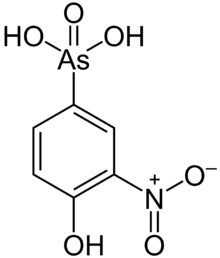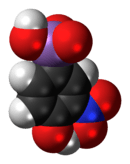Roxarsone
| |||
| Names | |||
|---|---|---|---|
| IUPAC name
4-Hydroxy-3-nitrobenzenearsonic acid | |||
| Systematic IUPAC name
(4-Hydroxy-3-nitrophenyl)arsonic acid[1] | |||
| Other names
3-Nitro-4-hydroxyphenyl arsonic acid 2-Nitrophenol-4-arsonic acid | |||
| Identifiers | |||
3D model (JSmol) |
|||
| 1976533 | |||
| ChEBI | |||
| ChEMBL | |||
| ChemSpider | |||
| ECHA InfoCard | 100.004.049 | ||
| EC Number | 204-453-7 | ||
| 1221211 | |||
| KEGG | |||
| MeSH | Roxarsone | ||
PubChem CID |
|||
| RTECS number | CY5250000 | ||
| UNII | |||
| UN number | 3465 | ||
| |||
| |||
| Properties | |||
| C 6AsNH 6O 6 | |||
| Molar mass | 263.0365 g mol−1 | ||
| Melting point | > 300 °C (572 °F; 573 K) | ||
| Hazards | |||
| GHS pictograms |   | ||
| GHS signal word | DANGER | ||
| H301, H331, H410 | |||
| P261, P273, P301+310, P311, P501 | |||
Except where otherwise noted, data are given for materials in their standard state (at 25 °C [77 °F], 100 kPa). | |||
| Infobox references | |||
Roxarsone is an organoarsenic compound that was widely used in poultry production prior to June of 2011[2] as a feed additive to increase weight gain and improve feed efficiency, and as a coccidiostat.[3] The drug is also approved in the United States for use in pigs.[3] Roxarsone is marketed as 3-Nitro by Zoetis, a former subsidiary of Pfizer now a publicly traded company. In 2006, approximately one million kilograms of roxarsone were produced in the U.S.[4]
Roxarsone is one of four arsenical animal drugs approved by the U.S. Food and Drug Administration (FDA) for use in poultry and/or swine, along with nitarsone, arsanilic acid, and carbarsone.[3] In September 2013, the FDA announced that Zoetis and Fleming Laboratories would voluntarily withdraw current roxarsone, arsanilic acid, and carbarsone approvals, leaving only nitarsone approvals in place.[5] In 2015 FDA withdraw the approval of using nitarsone in animal feeds. The ban came into effect at the end of 2015.[6] Roxarsone is banned in the European Union.[7]
Production and applications
Roxarsone is a derivative of phenylarsonic acid (C6H5As(O)(OH)2). It was first reported in a 1923 British patent that described the nitration and diazotization of arsanilic acid.[8] When blended with calcite powder, it is used in poultry feed premixes and is usually available in 5%, 20% and 50% concentrations.
Controversy
Roxarsone has attracted attention as a source of arsenic contamination of poultry and other foods.[9][10] In June 2011, Pfizer suspended sale of roxarsone in the U.S. in response to a study by the Food and Drug Administration (FDA);[11] the FDA found that roxarsone use was associated with elevated levels of inorganic arsenic in chicken livers.[12] An FDA press release stated that the findings raised "concerns of a very low but completely avoidable exposure to a carcinogen."[11] The voluntary suspension does not preempt Pfizer from selling roxarsone in the future, as FDA has not withdrawn its approval to market the drug in the U.S.[13][14] As of 2011, roxarsone was approved for use in 14 other countries as well.[13]
A 2013 market basket study linked the use of roxarsone and other arsenical feed additives to increased levels of inorganic arsenic in chicken breast meat.[15][16] Breast meat from conventionally produced chickens (in which arsenical use is permitted under U.S. law) had three times more inorganic arsenic than did breast meat from chickens produced according to USDA Organic standards. The USDA Organic program prohibits arsenical use in organic chicken production. The researchers also found that inorganic arsenic concentrations were almost three times higher in samples with detectable levels of roxarsone than in samples without detectable roxarsone.
References
- ↑ "Roxarsone - PubChem Public Chemical Database". The PubChem Project. USA: National Center for Biotechnology Information. Descriptors Computed from Structure.
- ↑ "Arsenic in Chicken: Does chicken meat contain arsenic?". Chicken Check In. 2017-07-21. Retrieved 2018-03-20.
- 1 2 3 U.S. Food and Drug Administration (June 8, 2011). "Questions and Answers Regarding 3-Nitro (Roxarsone)".
- ↑ Hileman, B. (April 9, 2007). "Arsenic in Chicken Production". Chemical and Engineering News. pp. 34–35.
- ↑ U.S. Food and Drug Administration (September 20, 2011). "FDA Response to Citizen Petition on Arsenic-based Animal Drugs".
- ↑ U.S. Food and Drug Administration (April 1, 2015). "FDA Announces Pending Withdrawal of Approval of Nitarsone".
- ↑ Some Arsenic With That Supermarket Chicken? Tom Philpott Sat Jun. 11, 2011
- ↑ GB 226255 19230718
- ↑ Institute for Agriculture and Trade Policy (April 4, 2006). "Playing Chicken: Avoiding Arsenic in Your Meat".
- ↑ Consumer Reports (November 2012). "Arsenic in your food".
- 1 2 U.S. Food and Drug Administration (June 8, 2011). "FDA: Pfizer will voluntarily suspend sale of animal drug 3-Nitro".
- ↑ Cevallos, M. (June 9, 2011). "Arsenic-containing drug in chicken feed to be pulled from U.S". LA Times.
- 1 2 Gardiner Harris & Denise Grady (June 8, 2011). "Pfizer Suspends Sales of Chicken Drug With Arsenic". New York Times.
- ↑ U.S. Food and Drug Administration. "Animal Drugs @ FDA".
- ↑ KE Nachman; PA Baron; G Raber; KA Francesconi; A Navas-Acien; DC Love (2013). "Roxarsone, Inorganic Arsenic, and Other Arsenic Species in Chicken: A U.S.-Based Market Basket Sample" (PDF). Environmental Health Perspectives. 121: 818–824. doi:10.1289/ehp.1206245.
- ↑ Sabrina Tavernise (May 11, 2013). "Study Finds an Increase in Arsenic Levels in Chicken". New York Times.
Further reading
- J. R. Garbarino; A. J. Bednar; D. W. Rutherford; R. S. Beyer & R. L. Wershaw (2003). "Environmental Fate of Roxarsone in Poultry Litter. I. Degradation of Roxarsone during Composting". Environ. Sci. Technol. 37 (8): 1509–1514. doi:10.1021/es026219q. PMID 12731831.
- Chiou P. W.-S.; Chen K.-L.; Yu B. (1997). "Effects of roxarsone on performance, toxicity, tissue accumulation and residue of eggs and excreta in laying". Journal of the Science of Food and Agriculture. 74 (2): 229–236. doi:10.1002/(SICI)1097-0010(199706)74:2<229::AID-JSFA793>3.0.CO;2-F.
- R. L. Wershaw; J. R. Garbarino & M. R. Burkhardt. "Roxarsone in Natural Water Systems" (PDF).
- KB Kerr; JR Narveson; FA Lux (1969). "Toxicity of an organic arsenical, 3-nitro-4-hydroxyphenylarsonic acid. Residues in chicken tissues". Journal of Agricultural and Food Chemistry. 17 (6): 1400. doi:10.1021/jf60166a021.

